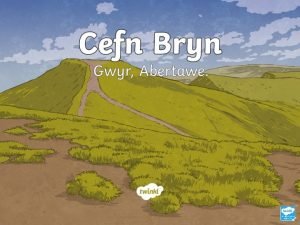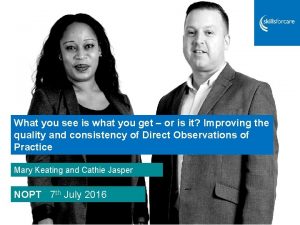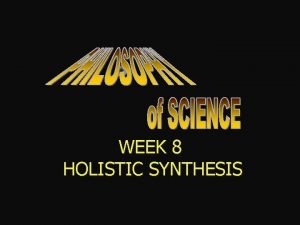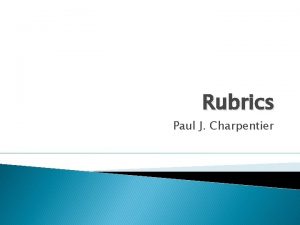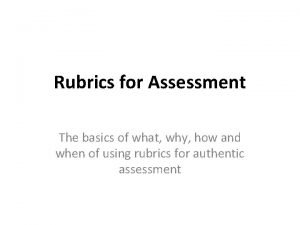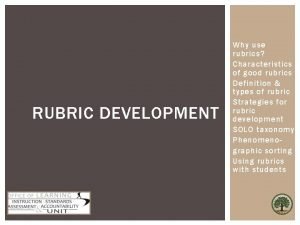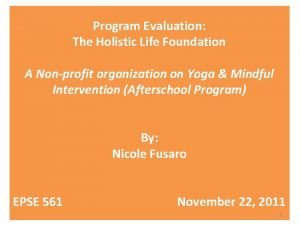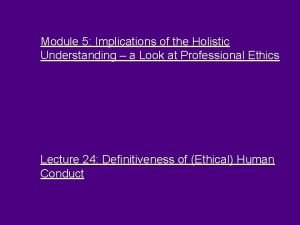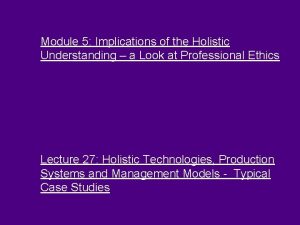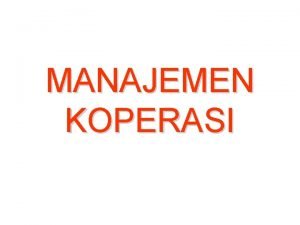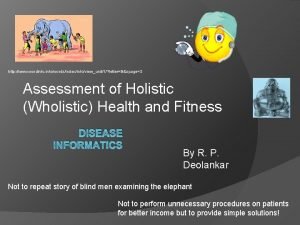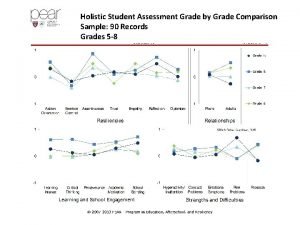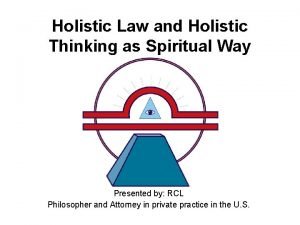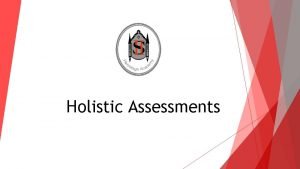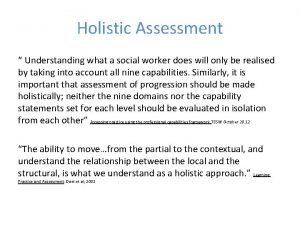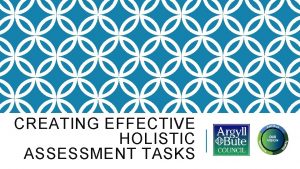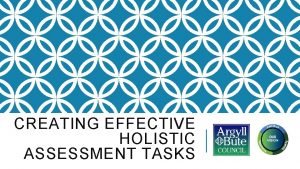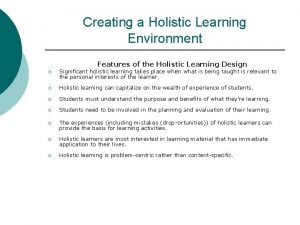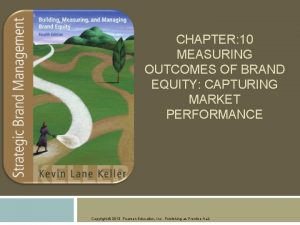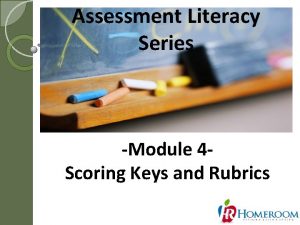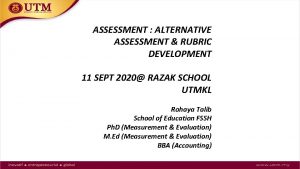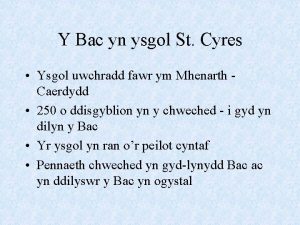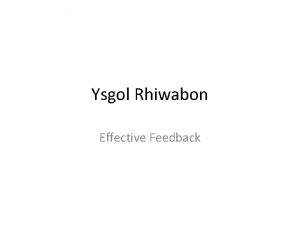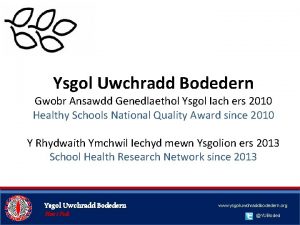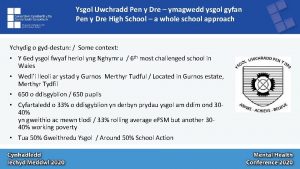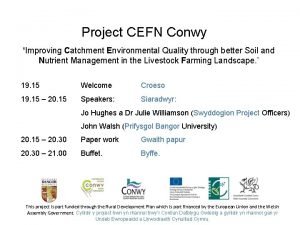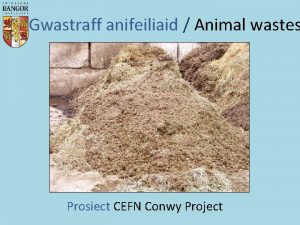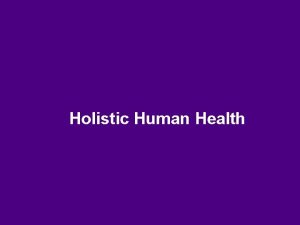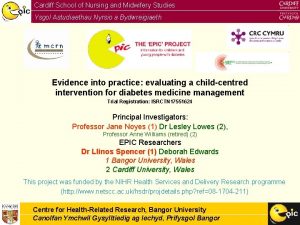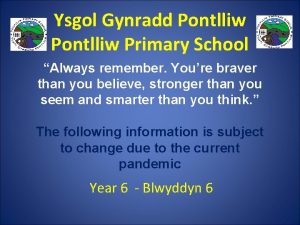Ysgol Gymunedol Cefn Hengoed Community School A HOLISTIC


































- Slides: 34

Ysgol Gymunedol Cefn Hengoed Community School A HOLISTIC APPROACH TO ATTENDANCE Estyn Conference – Tackling Deprivation and Raising Standards Wednesday 7 th May 2014 Sue Hollister – Headteacher sue. hollister@swansea-edunet. gov. uk Michelle Evans – Senior Pastoral Support Officer michelle. evans@swansea-edunet. gov. uk

Tackling Deprivation and Raising Standards – our context PORT TENNANT/ST THOMAS/BONYMAEN/ WINCH WEN/TRALLWN 11 th most deprived ward in Wales (WIMD) 43. 5% Free School Meals 73% of our pupils live in the 30% most deprived parts of Wales A decade of budget deficit

The Challenges Underpinning Our Journey to Tackle Deprivation and Raise Standards The Framework for Attendance Improvement Key Recommendations Estyn 2005 R 2 extend the range of teaching and learning styles to ensure: - appropriateness to the learning of the pupils of all ability levels, and - pupils become more actively involved in their own learning R 4 in the light of issues and developments arising from the 14 -19 agenda, evaluate and improve the curriculum provision in KS 4 for pupils of average and lower ability R 6 improve attendance and punctuality

Estyn Report 2005 69 Attendance and punctuality areas for improvement. Attendance for the three full terms prior to inspection is unsatisfactory. However, it is an improvement since the last inspection.

Our Strategic Approach to Tackling Deprivation and Raising Standards Estyn R 2 Extend the Range of Teaching and Learning Styles Curriculum 2008 2007 -08 Development of Skills Based Curriculum in KS 3 Rewriting of all KS 3 Schemes of Work Skills Development Explicit in So. W 2008 -09 Development of accredited Key Skills qualifications at end of KS 3 to maximise post-exam period Bid to join Pilot of 14 -16 Welsh Baccalaureate 2009 -present Accredited Key Skills Programme KS 3 Welsh Baccalaureate KS 4

2009 -10 Raise 4 Cluster 8 Reading Behaviours Literacy Strategy modelled by English department with Humanities Basic Skills Focus Group developed to tackle those mainstream pupils whose Literacy and Numeracy were most challenged 2010 -11 Raise 4 Cluster 8 Reading Behaviours Literacy Strategy rolled out across whole school – intensive staff and pupil training Basic Skills Focus Group embedding targeted support training staff across school 2011 -12 SEG Cluster Literacy Identification of pupils in 3, 4, 5, 6, 7, 8, 9 with RA 6 months or more below chronological age Basic Skills IEPs in place for Basic Skills Underattaining Cohort

Estyn R 4 Development of a Curriculum Relevant to Needs 2006 -2008 Vocational Options introduced – Vocational OR Academic Collaboration with College initiated common Eastside timetable/school day 2008 -2010 Vocational Options offered alongside School Based academic options to mix and match 2011 -2012 Collaboration with Eastside schools to (i) share a contracted lecturer to use in-house (ii) share college based PLQ course (iii) share college based Construction course

2012 -2013 Develop curriculum in school to deliver vocational and academic options using contracted lecturers/part time specialist staff/shared lecturers with other schools/maximising skills of new generation of teachers. Retain highly specialised vocational courses in college. CHANGING THE HOW rather than the WHAT

School Effectiveness Framework School Priority: Improvement and Accountability Priority Attendance: o WAG attendance return o 2011 -12 attendance return to LEA Strategic Priority 2008 -11 A 8 1. 1 2 2. 1 2 3. 1 2 A 9 3. 1 2 A 11 5. 1, 3, 5, 7 2011 -14 4 B 4 C Objective 2008 -11 A 8 unauthorised 2. 1 2 absences 2011 -14 4 B 4 C Resources Finance Incorporate new WAG attendance codes SH/CW/BG/DM/CL/ Pastoral budget Attendance: o Reduce Responsibility Date into attendance records. Continue improved trend in attendance to 92%. Regular monitoring through Attendance Focus Group/PLC and EWO/PSOs. Referral for further support by Learning Coordinators/PSOs to EWO and other agencies. Ongoing targeting of pupils with persistent attendance concerns (70%-85%) with Attendance Support Officer and ENGAGE team. Learning House involvement for persistent attendance concerns (<70%) at KS 3. Rewards/parental communication to reflect very good attendance. PSOs (and ENGAGE team in KS 4) target 80 -90% attenders including pupil/parental meetings with PSOs and EWO. Attendance Focus Group/PLC to meet half termly to monitor and implement intervention strategies. Letters, phone calls, Schoolcomm texts to parents/carers. Prompt EWO/ASO referrals for ongoing problems. ME/AR/KBM/EWO/ ASO/ENGAGE Team Ongoing – July 2012 element allocated for attendance Dedicated PSO time daily to organise attendance issues 6 x 2 hour meetings/year of Attendance Focus Group/ PLC Success Criteria New WAG attendance SH/CW/BG/DM/CL/ ME/AR/KBM/EWO/ ASO/ENGAGE Team Ongoing – July 2012 Schoolcomms/ Postage cost code in Budget Dedicated meeting time chaired by Headteacher PSO/ENGAGE Team dedicated time and specific roles EWO/PSO/ENGAGE Team dedicated time codes used accurately and consistently. Whole School attendance at 92% June 2012. Impact of improved attendance on pupil achievement and whole school outcomes monitored year on year. Attendance remaining in top quartile for Family of Schools. Improved attendance explicitly transforming pupil experience and wellbeing and recognised as Sector Leading. Attendance Focus Group/PLC continuing to improve communication regarding unauthorised absence issues. Unauthorised absences <1% in 2011 -12.

School Effectiveness Framework School Priority: Improvement and Accountability Priority LEA Strategic Priority Objective Responsibility Date Resources Finance Success Criteria Attendance: o Family Holidays 2008 -11 A 8 1. 1 2 2011 -14 4 B 4 C Leave of Absence forms for term time CW/BG/DM/CL/ME/ AR/KBM/ENGAGE Team/EWO Ongoing – July 2012 PSO/ENGAGE Attendance: o Punctuality and Truancy Attendance: o Business Continuity holidays to be completed and a formal application process observed by parents/carers. Increase awareness of parents/carers of maximum authorised allowance. Increased awareness of parents/carers of examination calendar to minimise clashes. 2008 -11 A 8 1. 1 2 2. 1 2 A 9 1. 1 2 2011 -14 4 B 4 C Monitoring of lateness. Consistent application of sanctions for 2008 -11 C 1 1. 1 2 2011 -14 4 B Ensure WAG/LEA instruction/guidance persistent lateness involving parents/carers. Electronic lesson by lesson monitoring to drive truancy monitoring. Inclusion Unit a sanction for truancy. followed to enable effective attendance housekeeping during unanticipated school closure e. g. severe weather. Holidays taken in term team time reduced. Parents/carers aware of HC/CW/BG/DM/ CL/ME/AR/KBM/ ENGAGE Team/ EWO/ASO Ongoing – July 2012 PSO/ENGAGE SH/SG/CL/ME/ AR/EWO PSO time team time EWO/ASO time Inclusion Unit supervision time exam timetable and annual holiday allowance. Website explicitly updated with key school dates and term calendar. Punctuality improved. Truancy identification visible, successful and a deterrent. Inclusion Unit providing sanction for truancy and enabling education to continue uninterrupted. Attendance impact due to unexpected closure minimised.

Estyn R 6 Improve Attendance and Punctuality 1. Curriculum increasingly relevant and fine tuned to needs. 2. Teaching and Learning increasingly fine tuned to individual learning needs. 3. (i) Collaborative working at KS 4 to maximise (1) and (2). (ii) Collaborative working inextricably linked at KS 2/3 to maximise (1) and (2). 4. 2 Pastoral Support Officers appointed with RAISE funding, one more with ENGAGE and now sustained with PDG with responsibility for supporting attendance improvement. 5. Rigorous attendance housekeeping and monitoring (Pastoral Support Officers/EWO).

5. Attendance a strategic priority since 2007 (i) Item 1 on all meeting agendae Governing Body Leadership Team Senior Pastoral Team (ii) School priority on School Development Plan (iii) Staffing investment – Expanded Pastoral Team Senior Pastoral Team restructure in Pupil Welfare and Support Expanded Cost Centre line for Schoolcomms Text Messaging Service (iv) ENGAGE funding – invested in KS 4 Learning Coaches targeted at identified pupils at risk of becoming NEETS – improving attendance and enabling participation. PDG extended and expanded Attendance roles and functions. (v) Attendance Focus Group – monthly meetings chaired by Headteacher (vi) Staff training – to improve consistent linking of attendance and progress in pupil feedback

6. Pupil Welfare and Support – Breakfast Club 7. 40 am-8. 40 am to build on excellent work in partner primaries. Supervisor funded by PDG. - individually targeted Family Support meetings focused on attendance - Multi agency working focused on attendance (So To Do/Ed Psych/Behaviour Support/ELi. S/EWO/EMLA/LAC/SEN/Cluster Primaries) - after school Wrap Around provision to build on excellent models in Cluster Primaries (Own Zone/Chill Zone/Learn Zone) 3. 00 pm-4. 40 pm 7. Rewards and Awards - School Annual Awards Evening attendance awards presented by EWO (95% over the year +) - termly letters to parents for pupils with 95%+ attendance - Special Awards for whole year 100% attendance

Leading to • improved attendance in every year group • improved attendance across groups of pupils • reduced unauthorised absences • improved KS 2/3, KS 3/4 transition • increased progression to post-16 as a result of improved attendance and engagement • reduction in % of pupils at risk of NEETS and % leaving without qualifications

Ysgol Gymunedol Cefn Hengoed Community School Improving Attendance – Impact of Actions Estyn 2005 to Estyn 2011 and beyond

School Inspection November 2005 Attendance was highlighted as a shortcoming by Estyn! Academic Year 2004/2005 Group Year 7 Year 8 Year 9 Year 10 Year 11 Totals Authorised 0. 5 0. 7 1. 1 0. 9 0. 6 0. 7 Unauthorised 6. 8 7. 4 9. 9 19. 9 37. 4 15. 8 % Girls 94. 1 93. 9 91. 4 81. 2 65. 4 85. 4 % Boys 91. 5 90. 5 86. 8 77. 3 59 81. 7 % Overall 92. 7 91. 9 89 79. 2 62 83. 4 % Boys 87. 5 85. 7 82. 3 86. 6 81. 7 84. 7 % Overall 87. 8 86. 8 84. 7 85. 4 81. 9 85. 4 Academic Year 2005/2006 Group Year 7 Year 8 Year 9 Year 10 Year 11 Totals Authorised 9 9 10 7. 9 6. 9 8. 6 Unauthorised 3. 2 4. 3 5. 3 6. 7 11. 2 6. 1 % Girls 88. 1 88 87. 9 84. 2 82. 1 86. 1

Academic Year 2006/2007 % Girls 90. 2 85. 6 83. 2 85. 3 88. 5 86. 6 Group Authorised Unauthorised Year 7 8. 3 2 Year 8 10. 7 3. 7 Year 9 11. 8 4. 8 Year 10 10. 3 7. 5 Year 11 6 5. 1 Totals 9. 5 6. 1 • 2 Pastoral Support Officers employed through RAISE funding. % Boys 89 85. 7 83. 6 79. 7 89. 2 85. 2 % Overall 89. 7 85. 6 83. 5 82. 2 88. 9 85. 9 1 st year of vocational options Focusing on 1 PSO for KS 4 • 1 employed to work with Years 7 -9 the other Years 10 -11 Academic Year 2007/2008 Group Year 7 Year 8 Year 9 Year 10 Year 11 Totals • Authorised 8. 9 10. 4 11. 3 11. 5 6. 5 9. 7 Same as above Unauthorised % Girls 0. 5 91. 5 0. 3 89. 4 0. 8 88 1. 7 87. 2 2. 6 93 1. 2 89. 7 % Boys 89. 7 89. 4 87. 9 86. 4 89. 3 88. 4 % Overall 90. 6 89. 4 88 86. 8 90. 9 89. 1 2 years of vocational options

Academic Year 2008/2009 Group Year 7 Year 8 Year 9 Year 10 Year 11 Authorised 8. 9 9. 8 10. 4 8. 7 5. 8 Unauthorised 1. 1 1. 2 1. 4 1. 6 2. 6 % Girls % Boys 90. 1 90 89. 6 88. 4 88. 1 88. 3 90. 3 89. 1 92 91. 2 Totals 8. 7 1. 6 90 89. 5 • Still 2 Pastoral Support Officers but sustained from school funding. % Overall 90 89 88. 2 89. 7 91. 6 AWCD – Quartile 1 89. 7 • During the Summer term another PSO was employed to work just with Year 9 due to identification of need for further support and improvement in lower school Academic Year 2009/2010 Group Year 7 Year 8 Year 9 Year 10 Year 11 Totals • Authorised 8. 9 9. 5 9 8. 9 6. 2 8. 5 Unauthorised 0. 9 1. 5 1. 2 0. 8 1. 2 % Girls % Boys 90. 6 89. 2 88. 4 89. 4 90. 1 88. 9 89. 2 90. 6 92. 8 93 90. 2 % Overall 89. 9 88. 9 89. 5 89. 9 92. 9 90. 2 Three PSOs employed working with Years 7+8 / Years 9+10 / Year 11 • Male Attendance Project Worker appointed to team and a fantastic role model for boys. • Boys attendance improvement was noteworthy – a result of a curriculum which met their needs. AWCD – Quartile 1

Academic Year 2010/2011 Group Year 7 Year 8 Year 9 Year 10 Year 11 Totals Authorised 7. 8 9. 4 9. 3 6. 5 8. 6 8. 3 Unauthorised 0. 1 0. 7 1. 4 0. 9 0. 8 % Girls 92. 8 89. 9 89 92. 6 90 90. 8 % Boys 91. 4 89. 9 89. 4 92. 6 91. 2 90. 9 % Overall 92. 1 89. 9 89. 2 92. 6 90. 9 AWCD – Quartile 1 Best ever school attendance Best ever attendance of boys • Still 3 PSOs continue to work with Years 7+8 / Years 9+10 / Year 11 because the formula works for us. • Autumn term 1 Learning Coach working with Year 11 • For 2011 – 2012 3 learning coaches working with years 10 and 11 Academic Year 2011/2012 Group Year 7 Year 8 Year 9 Year 10 Year 11 Totals • Authorised 7. 3 9. 0 8. 5 8. 3 7. 2 8. 1 Unauthorised 0. 6 0. 4 1. 3 1. 2 0. 8 % Girls 92. 9 91. 3 89. 5 90. 2 92. 2 91. 2 PDG funding used to introduce a Behaviour Support Assistant % Boys 91. 1 90. 9 90. 8 91. 9 90. 9 % Overall 92. 1 90. 6 90. 2 90. 5 92 91. 1 AWCD – Quartile 1 First time every year group above 90% Year 11 boys highest attending group in school

The Improvement Academic Year 2004/2005 Group Year 7 Year 8 Year 9 Year 10 Year 11 Authorised 0. 5 0. 7 1. 1 0. 9 0. 6 Unauthorised 6. 8 7. 4 9. 9 19. 9 37. 4 % Girls 94. 1 93. 9 91. 4 81. 2 65. 4 % Boys 91. 5 90. 5 86. 8 77. 3 59 % Overall 92. 7 91. 9 89 79. 2 62 Totals 0. 7 15. 8 85. 4 81. 7 83. 4 Academic Year 2012/13 Group Year 7 Year 8 Year 9 Year 10 Year 11 Authorised 6. 8 8. 5 8. 4 7. 1 7. 5 Unauthorised 0. 2 0. 8 0. 3 1. 1 0. 8 % Girls 93. 0 90. 3 91. 1 91. 9 91. 5 % Boys 93. 2 91. 3 91. 7 91. 8 % Overall 93. 1 90. 7 91. 3 91. 8 91. 7 Totals 7. 7 0. 6 91. 8 91. 7

Reporting on Groups of Pupils to Governing Body ATTENDANCE REPORT 12/13 Groups AUTHORISED ABSENCES (%) ATTENDANCE (%) UNAUTHORISED ABSENCES (%) BOYS GIRLS TOTAL Ethnic Minority 94. 9 94. 1 94. 5 5. 1 5. 9 5. 5 0. 0 LAC 96. 4 84. 9 92. 0 3. 6 14. 9 8. 0 0. 1 0. 0 SEN 91. 7 93. 8 92. 2 7. 4 6. 1 7. 0 0. 9 0. 1 0. 7 FSM 89. 2 88. 5 88. 8 9. 4 10. 5 10. 0 1. 4 1. 0 1. 2 Non. FSM 92. 3 92. 8 92. 5 7. 0 0. 3 0. 2 Date range ~ 03/09/2012 to 25/01/2013 Enables clear identification of areas of focus

Ysgol Gymunedol Cefn Hengoed Community School Specific Actions to Tackle Deprivation and Raise Standards The Role of the Pastoral Support Officer Team Daily Routine of Attendance Monitoring

• Check absence line and input into Sims • Use Schoolcomms to text parents when pupils are absent from • • • school and no contact has been made Monitoring registers every lesson Spot Truancy checks with the use of Schoolcomms and electronic lesson monitor Weekly meetings with EWO to address concerns with pupils with attendance below 80% or 3 days no contact Liaise with parents, pupils and form tutors Weekly housekeeping to ensure unauthorised absence is kept to a minimum

Ysgol Gymunedol Cefn Hengoed Community School The Role of the Pastoral Support Officer Team What we have done to improve

Improvements which have impacted • Restructure of School Pastoral system. • Monthly Attendance Focus Group Meeting which consists of Headteacher, • • • EWO, Pastoral Support Officers and Lead ENGAGE (now PDG) Learning Coach. Schoolcomms to contact parents by text. Lesson by lesson registration. Consistency across the whole school using correct attendance codes. Scrutinise attendance codes to ensure correct codes are used and attendance % maximised reflecting appropriate code e. g. Bad weather/school closure. ENGAGE Learning Coaches to support access to the curriculum for our most vulnerable attenders. Excellent Transition links between KS 2/3/4 and 5 and excellent communication with partner primaries. All PSOs and Learning Co-ordinators working together in one base. Monthly Housekeeping blitzes with internal audits to cross check. Good links with alternative provision providers; in 2011 -2012 a dedicated ENGAGE role.

Where can we still go? 91. 1% (2011 -12 end %) is still not good enough to maximise pupil progress. Where KS 4 has been a major focus, Middle School (Yrs 8 & 9) now a focus. Behaviour Support assistant employed using PDG funding to further support attendance monitoring of pupils on FSM. Extend in depth focus to pupils with attendance between 80% - 90%. School demonstrates that these pupils are limited on the D/C borderline due to attendance. Schoolcomms facility extended to enable parents/carers to text school, in response to parental demand (PDG part funded). Pupils at risk of becoming NEETs now placed on PSP part timetable at school instead of Education Other Than at School in order to more closely monitor attendance and impact on progress. Focus on the attendance of groups of pupils e. g. FSM v non FSM, Minority Ethnic, LAC, SEN, Travellers to more clinically inform for trouble shooting. .

Tackling Deprivation and Raising Standards – Impact and Outcomes ESTYN DECEMBER 2011 Attendance In LEA School Profile meeting 2010 and 2011, school identified Attendance Improvement as Sector Leading Practice. Estyn interviewed: Headteacher Deputy Headteacher Learning Co-ordinators (Heads of Lower and Middle School) Selected Form Tutors during Registration Admin Staff registering latecomers and function of signing in/out Pupils (i) in Registration (ii) in Pupil Group interviews

Estyn scrutinised: Attendance data Registration processes Absence follow up processes Administration processes Schoolcomms systems/parental feedback Governing Body Minutes to test ‘Item 1 on Agenda’ Sample Leadership/Senior Pastoral/Pastoral minutes Attendance Focus Group

Estyn noted in discussion with Nominee: Scrutiny Group an outstanding feature Weekly bulletin as a tool to flag up pupil activity out of class Effectiveness of Housekeeping Maximising use of SIMS (Flagging pupils/analysing data) Expectation of Context by ‘outsiders’ Versatility of Schoolcomms Consistency of answers following staff and pupil interviews Success of collaborative and strategic partnerships Integrated factors contributing to improved attendance Lead Inspector summarised in final feedback: Improvement in attendance rates are outstanding. They have improved considerably over the last 3 years. Compared with similar schools, they are well above average and in the top quarter. Nearly all pupils are punctual to lessons.


Impact on Outcomes at Key Stage 3 The % of pupils in successive Year 9 cohorts achieving Level 5 and above in Core Subjects: English Maths Science CSI 2006 58% 55% 69% 47% 2007 55% 54% 66% 45% 2008 58% 47% 53% 38% 2009 59% 49% 71% 45% 2010 63% 60% 66% 55. 2% 2011 66% 72% 70% 63% 2012 66% 72% 74% 65% 2013 77% 75% 77% 71%

Impact on Outcomes at Key Stage 4 The overall performance of successive Year 11 cohorts expressed in terms of the national indicators – before, during and as a result of strategies. % Achieving Core Subject 1 or more Indicator A*-G Level 2 incl Eng & Maths Level 2 Indicator Level 1 Indicator 2004 - 26% 86% 97% 2005 - 34% 74% 90% 2006 - 32% 76% 89% Average GCSE Points Score % with no qualification s 12% 30 2% 28% 31 7% 19% Average Total Points Score per Pupil 5. 4% 197 2007 - 41% 85% 92% 23. 4% 292 3. 5% 2008 31% 40% 83% 94% 335 4. 9% 2009 33% 42% 84% 91% 327 5. 3% 2010 36% 49% 90% 98. 5% 364 1. 5% 2011 40% 61 % 97 % 100% 37% 525 0% 2012 31% 64% 92% 100% 31% 491 0% 2013 43% 67% 96% 99% 43% 543 1%

Along the Improvement Journey Estyn inspection report December 2011 Standards Good Key Question 1 Outcomes Good Prospects for Improvement Excellent Key Question 2 Provision Excellent Key Question 3 Leadership Excellent Aspects Judged Good Aspects Judged Excellent Standards Teaching Resource Management Wellbeing Learning Experiences Care, support and guidance Learning environment Leadership Partnership Working Improving Quality Sector Leading Practice Best Practice Reports • A holistic approach to improving attendance • Developing a skills programme for all pupils

Along the Improvement Journey Estyn Best Practice Guide November 2012 • Effective practice in tackling poverty and disadvantage in schools (1 of 10 schools in Wales) Welsh Government Standards Unit June 2013 • Key Stage 4 Mathematics: what works in 11 schools National Centre for Excellence in the Teaching of Mathematics July 2013 • Excellence in Mathematics Award Estyn Best Practice Guide October 2013 • Good practice in Mathematics at Key Stage 4 (1 of 10 schools in Wales) Estyn Thematic Report December 2013 • Twelve secondary school improvement journeys Reports yet to be published: Estyn Thematic Report (Summer 2014) • Best practice in ESDGC • Estyn Thematic Report (Summer 2014) Quality assurance – classroom observation for school improvement
 Cefn hengoed community centre
Cefn hengoed community centre Cefn bryn mawr
Cefn bryn mawr Ysgol bryn alyn canteen
Ysgol bryn alyn canteen Ysgol bro tawe
Ysgol bro tawe Nifer o ysgolion
Nifer o ysgolion Community action cycle for community mobilization
Community action cycle for community mobilization Example of holistic assessment
Example of holistic assessment Holistic approach in qualitative research
Holistic approach in qualitative research Experiencialism
Experiencialism Dichotomistic
Dichotomistic Example of holistic rubric
Example of holistic rubric Holistic rubric example
Holistic rubric example Why use rubrics
Why use rubrics Holistic life foundation
Holistic life foundation Performance assessment
Performance assessment Definitiveness of ethical human conduct is also known as
Definitiveness of ethical human conduct is also known as Case studies of typical holistic technologies
Case studies of typical holistic technologies Harmony in the nature and existence
Harmony in the nature and existence Materi manajemen koperasi
Materi manajemen koperasi Holistic wholistic
Holistic wholistic Holistic and analytic rubrics difference
Holistic and analytic rubrics difference Example of holistic assessment
Example of holistic assessment Holistic law
Holistic law Holistic assessments
Holistic assessments Example of holistic assessment
Example of holistic assessment Holistic marketing incorporates
Holistic marketing incorporates Example of holistic assessment
Example of holistic assessment Holistic assessment examples
Holistic assessment examples Holistic learning environment
Holistic learning environment Marketing based comparative approach
Marketing based comparative approach Scoring key example
Scoring key example Holistic and analytic rubrics difference
Holistic and analytic rubrics difference Site:slidetodoc.com
Site:slidetodoc.com Adbominals
Adbominals Biodata ruqaiyah binti muhammad
Biodata ruqaiyah binti muhammad

